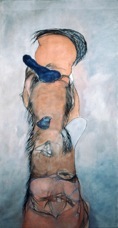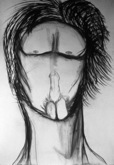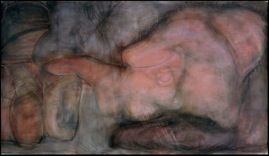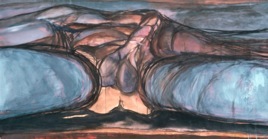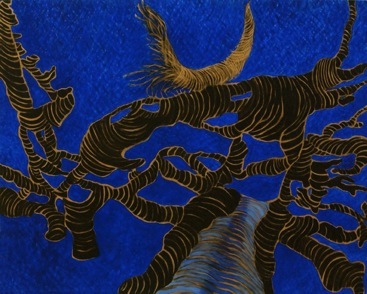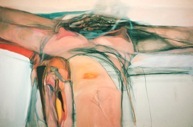
“Ms. Golden was among the early feminist artists of the 1960’s and 1970’s, and this small survey conveys, along with the flavor of a distinctive artistic personality, a sense of the political anger, antic humor, and conceptual experimentation that characterized the tangy first wave of the women’s movement. The work includes photographs of performance pieces and body art, and half-abstract paintings that demonstrate how delicate and beautiful political art can be.”
(Review of Solo Exhibition at Mitchell Algus Gallery 3/15/03 - 4/19/03)
Holland Cotter, The New York Times, Art Guide, Last Chance, Friday, April 18, 2003.
Mitchell Algus has a reputation for brining understudied careers back into view. And he sustains it this season with a series of solo shows devoted to feminist artists who first gained noticed in the the early 1970s. Eunice Golden was one of them, and this small survey of her early output conveys a sense of the political anger, antic humor and conceptual experimentation that characterized the tangy first wave of the women’s movement.
Some of the work takes the form of photographs of made-for-the-camera performance pieces. In them the nude body, in most cases male, is treated as manipulated raw material. In some cases, it is painted with images of female anatomy; in others it is wrapped in womb like cocoons of opaque plastic; in still others it is given ritualistic tasks to perform. One hilarious piece,”Clocking: Attitudes One Through Five,” records in cool, serial format the rise and fall of an erection.
“Ms. Golden’s 1970’s paintings are of particular interest. Some prefigure the work of younger artists now, as in the case of a tall, scroll like biomorphic piece that suggests a proto - Carroll Dunham. Others perform exploratory surgery on artists from Courbet to Magritte. Still others, like the three panel “Triptych for the Bicentennial” (1975), with its half abstract merging of bodies and maps, prove how quiet and beautiful political art can be.”
(Review of Solo Exhibition at Mitchell Algus Gallery 3/15/03 - 4/19/03)
Holland Cotter, The New York Times, Art Review, Friday, April 11, 2003.
“Painting by women took many directions. And the show points to some of them in anatomical close-ups by Eunice Golden ...and portraits by Alice Neel...”
(Review of Guild Hall Museum of East Hampton group exhibition “Personal and Political: The Woman’s Art Movement, 1969-75”)
Holland Cotter, The New York Times, Art Review, “Two Nods to Feminism, Long Snubbed by Curators” Oct. 11, 2002
“...Golden has even done a parody of Magritte’s famous Le Viol where the man’s genitals are superimposed on his face...her more abstract phallic fantasies are imaginative and often very beautiful - as are the various “landscapes she discovers in the male body.”
Margaret Walters, The Nude Male, A New Perspective, Paddington Press, New York/London, 1978
“ ‘Nothing But Nudes’ included a painting by Eunice Golden, Landscape #160 (1972) in which a free energetic repetitive line and brooding colors build up a pattern that has at first glance, pictorial intensity. At second glance, the intensity reveals an image - a writhing double image of male genitals and geological form. Geology and anatomy are made metaphors for one another by the artist’s imposition of her style.”
(Review of Whitney Museum of American Art group exhibition “Nothing But Nudes” 1977)
Carter Ratcliff, Art International, March/April 1977
“Eunice Golden’s abstracted sexual landscapes, one of which shows woman crucified on the land, paralleling Paul Shepard’s notion that the sexual anthropomorphism of the world is “the last defense against the naive reductionism and pseudo materialism of the (male) technological society which confers death and uniformity on the landscape.”
Lucy Lippard, From The Center, Feminist Essays on Women’s Art, Dutton, 1976
“Golden’s work has a power and grace that comes from an understanding of expressionism, figurative and abstract, a sure and vigorous draftsmanship and convincing sensuality...”
(Review of Solo Exhibition at Soho 20 Gallery, NYC 12/29/73 - 1/23/74)
Peter Frank, Soho Weekly News, On Art, 1/16/74, p.12
“...the biomorphic lyricism of Metamorphosis #10 results from an assimilation of Arp - like shapes into a landscape of the mind reminiscent in its somewhat narrative composition of a Miro fantasy. Layers of pastels are built up into a fleshy translucency which glows with the hallucinatory effect recalling to mind the hypnotic power of Baziotes’ paintings...Less directly dependent upon Surrealist prototypes is the large totemic phallus isolated against a neutral background in Metamorphosis #12. The shimmer of the transparent washes of oil on fine canvas and the hanging rather than stretching of the canvas reinforce the iconic impact of the image...in a way, this erect penis stands as a symbol for Golden’s search for the erotic and summarizes much of her earlier work.”
(Review of Solo Exhibition at Soho 20 Gallery, NYC, 12/29/73 - 1/23/74)
Susan Heinemann, Artforum, March 1974, p.80
“In a reversal of Magritte’s The Rape a woman’s face composed of her nude torso - Eunice Golden perpetrates a visual rape by twisting male genitals into grotesque heads...”
Dorothy Seiberling, New York Magazine, The Female View of Erotica, 1/11/74, p.55
“In a dry, draughtsmanly fashion, Eunice Golden paints male nudes passively reclining amidst a frenetic patterned background. A motif similar to a Pearlstein, her intent could not be more antithetical. The sensual lassitude of the figure draw one into mid-space, only to be psychically assaulted by tonal staccatos of the inchoate background patterns. The patterns are rendered in styles that defy any coherent reading. Her mental menace is an encouraging response to Pearlstein.” (Review of solo show Soho 20 January 1981)
Barnaby Ruhe, Art World, January 16-February 18, 1981
“Eunice Golden is a pioneering feminist artist. In the mid 1960’s she deployed a bold expressionist figuration at the service of a newly emerging sensibility. While other women were involved with self-definition and the revaluation of “woman’s work,” Golden presented the male body as a primal landscape of struggle and desire. Her work is unusual in the context of early feminism for this straightforward, metaphorical representation of men. Unlike Sylvia Sleigh’s gender odalisques, Golden does not turn tables to present the male figure as a sexual object according to patriarchal precedent. Rather, she subsumes the tropes of expressionism and surrealism to create new, aggressively visceral images of male sexuality and sexual politics from her woman’s perspective. The male body becomes female terrain: literal, romantic landscapes in which lurk pleasures and monsters too. Rape becomes the onerous face of realizably oneiric acts; patriotism, a penis wrapped in the flag.
In the early 1970’s Golden began working with performance, body art, photography and film. She photographed herself and her models naked, painted and serially presented. Male bodies were adorned with female anatomy. Female bodies were slathered with pigment and food and wrapped in transparent, plastic. Embracing couples were limned by the language of their encounters. Golden also made a number of well received feminist films in the early 1970’s. One, Blue Bananas and Other Meats (1973) was a recreation of the famous surrealist dinner in which a woman lay like a platter on the dining table. Golden however substituted a man, adroitly arranging the fruits of the feast to incorporate his crotch.
Where Eunice Golden’s late 1960s paintings anticipated earth art, in the early 1970s she moved into actual landscape, photographing figures formally, anatomically, marking time and space. Little seen at the time, Golden’s photographic work is a significant contribution to the body of 70s performance and documentation art.”
Mitchell Algus Gallery, New York City 2003
“In contrast to contemporaneous male artists (e.g., Chris Burden, Bruce Nauman, Vito Acconci) who tested the limits and measure of their own bodies, Golden orchestrated a situation in which the male body is “reoriented,” “scheduled,” “positioned” and “clocked,” by a female artist. She shifted the terms of artistic control and photographic documentation in ways that exceed the limits of simple role reversal. Golden’s photoworks mark a significant intervention in American conceptual and body art of the early 1970s, in part by gendering and sexualizing the male body rather than allowing it to stand in as the sign of a universal subject...Golden likewise positioned the male body - and the penis in particular - as a site of both humorous and erotic appeal. Whether filmed, photographed, or painted, the male figure in Golden’s work of the 1970s never includes a face. As though to insist on the primacy of her own vision, the artist furnished no identity for the men on whom she focused and made no reference to a particular male subjectivity.”
Richard Meyer, “Hard Targets: Male Bodies, Feminist Art, and The Force of Censorship in The 1970s.” Catalog for the exhibition WACK! Art and The Feminist Revolution, Curator Cornelia Butler, published by The Museum of Contemporary Art, L.A., Ca. 2007-2009
“...the work of Eunice Golden is a departure from all the previous work we have considered. It is difficult to “put a tag” on her work, since it is often a combination of many complex concerns. For instance,...”Dreamscape #5” is a work done in acrylics and graphite on canvas. It shows a figure which melts into its environment: the pattern of the rug on which the figure rests is echoed in the figure itself, creating a mysterious illusion of metamorphosis, as if the figure is in a state of change and transition. The pattern effects of rug and figure blend into a subtle amorphous whole that provokes and holds one’s attention. This quality of metamorphosis is again evident in a series of three drawings titled “Pas de Trois du Chats - a Study,” ...These charcoal on paper studies seem to represent “humanized” cats, whose agitated gestures remind us of boxers or combatants in defensive positions. Quick contour drawing combined with a scribble technique heightens the frenzied attitudes of the images, whose anatomical portions have a striking resemblance to human anatomy.”
Alexander Russo, The Challenge of Drawing, Prentice-Hall 1986 p. 215-6
“Her art appeared to emerge from a reservoir of unconscious, primordial, and subterranean images, a dimension that continues to inform her work. The late Ilya Bolotowsky, one of the leading abstract painters of the 20th century, compared her work to that of James Joyce because of her free, flowing and intuitive style. Like Joyces’s, Ms. Golden’s work reflects a human sexuality depicted frankly and realistically, and there is also that ineffable Joycean stream of consciousness, as if she were inviting the viewer into an uncensored conversation, a dialogue without convention or boundaries.
This is evidenced in the first two movements of her oeuvre: the male landscape nudes from 1960 to 1975 and the body landscapes and portraits from 1975 to 1980.
Whereas women’s bodies had for centuries been the muse and subject of much of men’s art, Ms. Golden went where no woman had gone before. As other feminist artists focused on vaginal iconography, Ms. Golden turned her gaze to men, to stare down, confront, objectify, inspect, eroticize, and understand.
One of the most heralded of her early works, “Landscape # 160” completed in 1972 and shown at the Whitney in 1977 was applauded by Carter Ratcliff, the prominent art critic who compared her work to Egon Schiele, the noted expressionist.
Throughout, her art is dominated by several interconnected themes: intimacy, humanness, vulnerability, and a cross-section of abstraction, surrealism, and expressionism.
Her eyes surveyed the paintings from her “Metamorphosis” series hanging on the walls like totems, prophetic icons of something still unknowable, but emerging. It is as if they were unfolding from a cocooned wellspring of some future primordial awakening.
Elise D’Haene, The East Hampton Star, Arts Section, 8/16/07, front page
_______________________________
